The Pixel Buds Pro 2 feature a few key improvements over the original Pixel Buds Pro. Two years after that release, Google is trying to incorporate better sound, Gemini interaction, and better battery life into a design that takes on a few physical changes.
Hardware & Design
On the surface, with the Pixel Buds Pro 2 earbuds tucked neatly away, there looks to be nothing different. The case is still the same eggshell color and shape with a very familiar texture.
If it ain’t broke…
Once the case is opened, Google’s changes are easy to see. The new Pixel Buds Pro 2 earbuds take up less physical space with a much smaller and more rounded chassis. The “G” logo is still prominently displayed on the outside of the earbud, and the only other landmark feature is a small mic grill along the top and bottom portions of the earbud’s faceplate.
Google made stark changes to the earbud design between these two Pro models. The new profile is much less like a bean and more of a little car’s wheel. In any case, it’s more concentric and takes up less space in your ear. A small rubber fin protrudes out of the bud to allow the user to “lock” the earbud in with a twisting motion when you put the earbuds on, handy for those times you know you’ll be doing more intense movements like running or general exercise. The stabilizer will keep the bud propped into the ear, preventing it from slipping away.
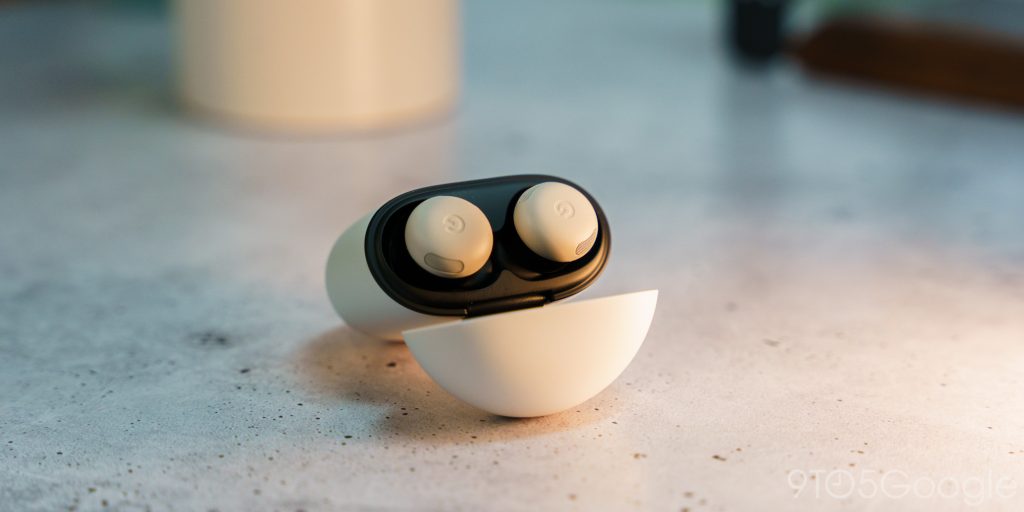
The overall change is immediately noticeable when putting them in my ears.
Not only do the buds feel different, but a new, improved audio jingle greets the wearer – a delightful little touch. The new design limits the amount of material actually touching your ear, allowing the wearer to casually listen for longer periods of time with less fatigue and discomfort. With Pixel Buds Pro 2, the earbud feels as though it’s floating, preventing that feeling that you get when you’ve had buds in for a while and certain parts of your ear become sore. I’ve not had that issue once.
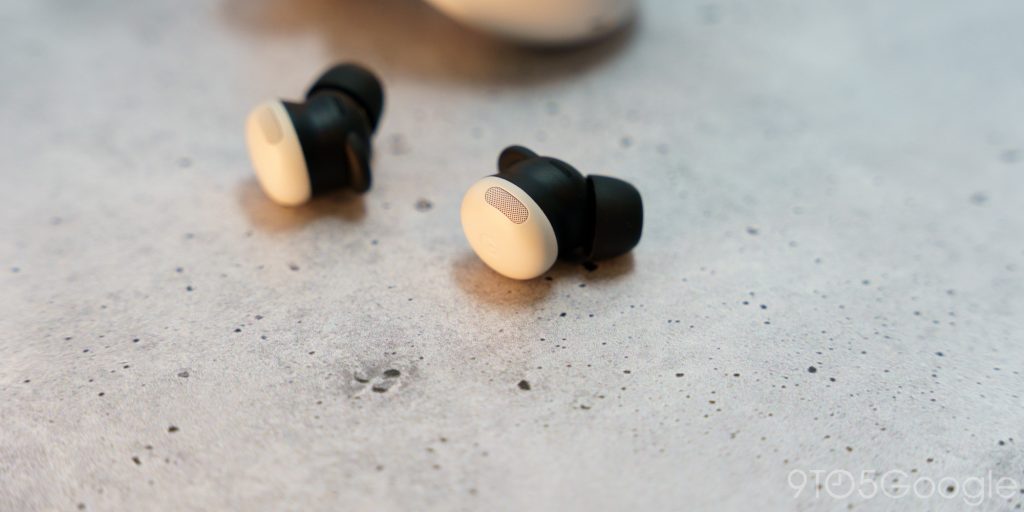
Of course, in-ear feel is a matter of preference. The new design doesn’t give the same initial feeling of having a bud seated in your ear properly; it sort of always feels like it’s hanging there. Our own Abner Li doesn’t find that feeling as secure but does note the (floating) comfort difference after an hour or so. I can go either way, but I see both points of preference.
On one hand, larger earbuds feel slightly more secure and offer a better seal sometimes. The new design relies solely on the seal between silicone and skin, which puts more pressure on the user to get the fit right. Multiple ear tips are included to narrow the fit down, as well as a fit check in the app to ensure sound is escpaing. In my experience, even if the Pixel Buds app says the fit is good, try other tips. Don’t be afraid to try different sizes for each ear, either.

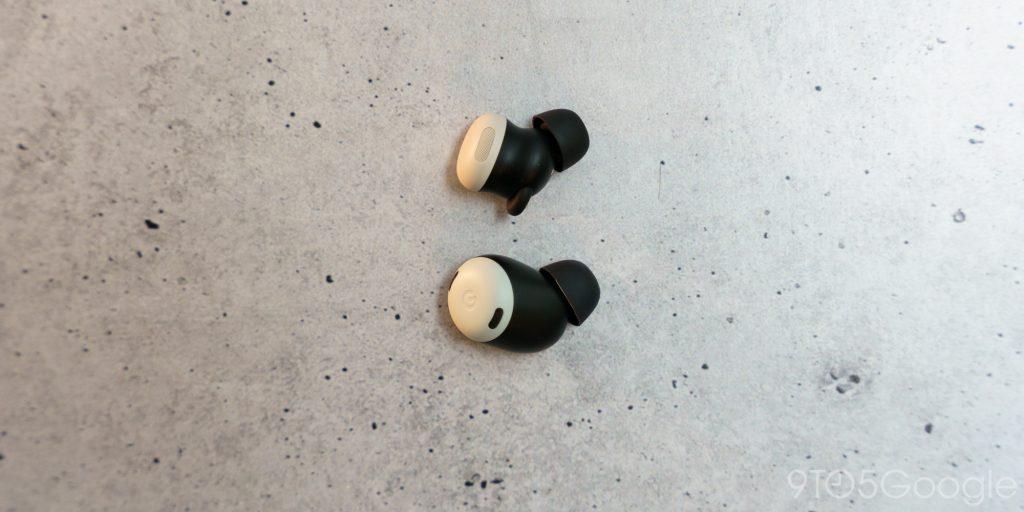
As an aside – because the earbuds essentially float, supported by the silicone tips, touch controls carry a much heavier echo. Tapping to play or pause can be jarring because all of that impact is absorbed by your ear canal. Tapping and swiping introduce friction, and if caught wrong, that tap or rubbing motion can echo into the ear. It’s not incredibly pleasant, though it isn’t an issue unique to Pixel Buds Pro 2.
As the Pixel Buds Pro 2 keeps the capacitive sensors, touch controls are one of two ways of controlling the buds. You can activate Gemini and ask it to perform actions, though an initial long press is still required.
Software and Gemini Live
Google equipped the Buds Pro 2 with a very similar array of touch controls as in the previous version. The generic play/pause, seek, and volume up/down actions are all available, though cemented in place. The press and hold action can be customized between noise cancellation modes and activating Gemini.
The controls are easy to use, though the smaller face of the buds makes them a little hit or miss. You can tap once to play or pause the audio, or you can tap twice to skip a track. Swiping your finger over the bud forward will raise the volume, and the reverse lowers it.
As far as digital assistants go, Google has baked in certain parts of the Gemini experience for the user. That simple press and hold will summon the AI assistant. The overall integration, though, feels a little lackluster. I was expecting a shortcut to access Gemini Live with ease, but instead, it’s required to say aloud, “Hey Google, let’s talk live” or something similar. Doing so begins a Gemini Live session with no visuals and through notification only.

As far as that experience goes, it is nice to be able to start a Gemini Live session, turn your phone’s screen off, and just chat. The interaction feels less forced than it might be on a Pixel phone. The purpose of Gemini Live, after all, is to facilitate normal interaction. With the Buds, that’s exactly what happens. You can chat like you were on the phone, as strange as that may sound. I saw this is a really cool way to interact with Gemini Live. It also gave me a chance to test the mics out, as Gemini didn’t exactly hear everything I had to say correctly.
The rest of Gemini’s integration makes me feel that putting “Gemini” instead of “Google Assistant” on the box was enough for the company. There isn’t much that feels inherently advanced about this integration of Google’s digital aid – more on that below.
The integration Google made with the Find My Device network does feel like a worthwhile addition, though. The Buds Pro 2 is visible within the Find Device app and can be tracked down as any other device. One of the cool choices Google made was to make both the case and buds individually trackable. The page allows you to select which part you want to track, whether that’s the case with the buds in them or an errant bud stuck in the couch. All three pieces can play a sound to help you locate them, though the case is much louder than the 11mm drivers in each earbud.
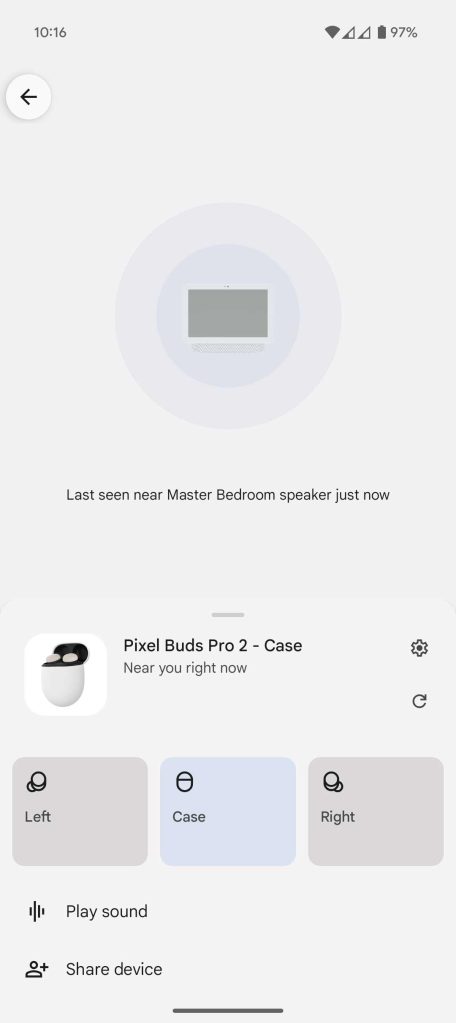

Gemini for headphones
The unveil of Gemini on Android phones was rough. In short, Google prioritized the conversational nature of Gemini over making a good phone assistant. To that team’s credit, they turned it around in the following months and it will be a pretty good Google Assistant replacement after everything that was announced at I/O 2024 around Gemini Extensions fully launches.
Unfortunately, Google fell into the same trap for the launch of Gemini on earbuds. Google over-indexed on Gemini Live and made that the showcase feature of Pixel Buds Pro 2 at the expense of offering a good assistant for headphones that can help with more mundane (daily) tasks.
When you invoke the main Gemini assistant (not Live) while the phone is in your pocket, the screen will still turn on to show the usual overlay. You cannot activate without your phone’s display turning on because Google says it is optimizing for how users prefer to have longer conversations with Gemini. To that end, Gemini lights the screen so people can reference the conversation transcript. That said, Google has “taken steps to reduce the likelihood of accidental touches by excluding certain functions when the screen is activated by Gemini voice commands.”
Even when I’m on the go, I’m still holding my phone. After getting Pixel Buds Pro 2 and invoking Gemini, I subconsciously kept tapping the lock button to turn the screen off, thinking it was an accidental screen activation. In the process, I canceled Gemini listening to me and its response.
Even worse is how Gemini on Pixel Buds Pro 2 can only read — “Hey Google, do I have any notifications” — alerts from messaging apps, like Google Messages, WhatsApp, Messenger, and Instagram, as well as Google Chat and Voice. Previously, you could set Google Assistant to read aloud notifications from specific apps, like news (breaking alerts) or even emails.
Pixel Buds Pro vs. Pro 2


With Gemini, Google tells us that it’s “reworking the notifications experience from the ground up.” The company is starting with messaging apps given their importance, and is “continuously working to enhance this experience further,” with other app types being considered.
We will continue to build on this and are deeply excited about the many different ways Gemini can enhance your overall notification experience for messaging and non-messaging apps when using Pixel Buds.
Another regression is how a verbal command — “read my notifications” — is the only way to have message alerts read aloud. Similar to the removal on existing Pixel Buds, Pixel Bids Pro 2 lacks the touch-and-hold feature that reads the time and any available notifications. That gesture was fantastic for those that wanted a subtle way to see their alerts if they can’t get to their phone, or just don’t like talking in public.
Gemini not having touch-and-hold and limited notifications is deeply disappointing and makes it a pretty bad assistant for headphones at launch. Instead of Pixel Buds Pro 2 building on those features, it feels like Gemini led to a great capability reset that ignores what people like about Assistant on Pixel Buds.
The Gemini assistant experience on phones eventually worked itself out but didn’t make for a good first impression, and that’s the case on Pixel Buds Pro 2.
Battery
The Pixel Buds Pro 2 also come with a nice battery boost, both in earbuds and case.
Both with ANC on and off, the earbuds get an extra hour of life. Through the case, however, the Pixel Buds Pro 2 get at least 10 or more hours of life. That totals 30 and 48 hours for ANC on and off, respectively.
That battery life boost, along with the new IPX4 water resistance rating, is likely the reason the case feels somewhat heavier than the previous model.
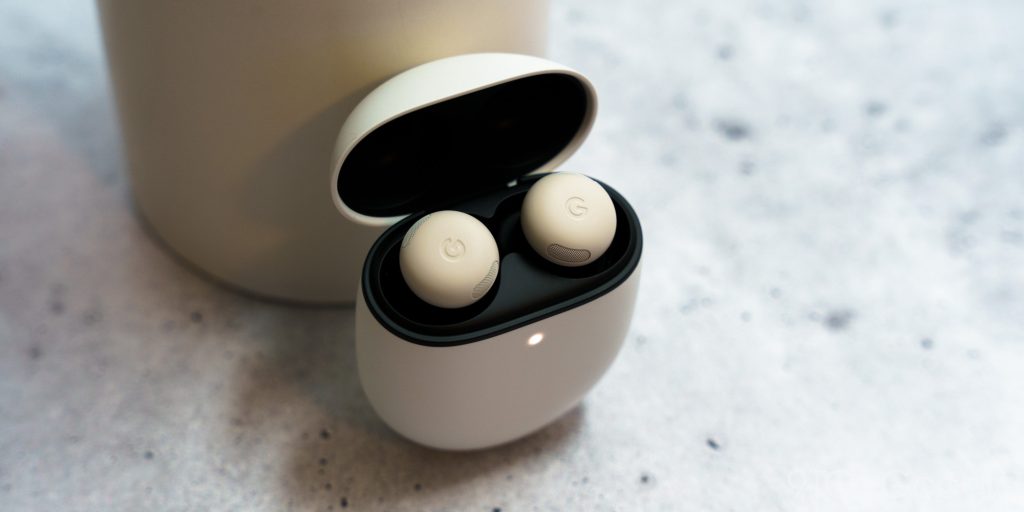
My time with the Buds has been a bit too brief to get a firm grasp on the battery life thus far, but my usage and battery estimates are lining up on the same track as Google’s claim. I’ve been thoroughly happy with how much I can get out of these earbuds — they seemingly just don’t stop.
Unless I’m on a plane or in a busy environment, I really don’t use ANC all that often, which means I generally see more battery life out of my earbuds. In this case, it really doesn’t make a massive difference. Google did a fine job of ensuring the buds will last a full day, even if you’re trying to tune everything out.
That, and the added bonus of charging the buds with much more power in the case, means the time between charges is pretty limited. When it comes time to charge, you’ve got USB-C or Qi wireless charging.
Audio quality
This is the part where I wasn’t entirely blown away by the Pixel Buds Pro 2. Then again, the previous model didn’t do the trick for me either. Maybe I’m a little pre-disposed because of my iffy experience with the first rendition, but I’d like to think I’m being even-keel here.
These Buds sound too boosted at the low end, and the high ends, like cymbals and hi-hats, simply lack detail. That sensation of a full sound stage comes crashing down when the high drum notes sound grainy and misplaced. Of course, that’s nitpicking. Most of the time, those detail losses go unnoticed, and the overall profile is absolutely acceptable.
Google added EQ adjustments a while back for the original Pixel Buds Pro, and this model carries that feature over. With that said, you can adjust the audio profile based on your preferences. It makes a little bit of a difference, but oftentimes, an EQ band is more of a bandaid than a true fix. The 11mm drivers just don’t hit it for me, and other new options like the OnePlus Buds Pro 3 earbuds — offering the same driver size — simply dominate the Pixel Buds Pro 2.

Google claims that the new A1 processor processes audio 90x faster than the speed of sound. That plays into ANC and transparency processing as well. Both of those work fine, but they aren’t perfect by any means. The new transparency mode is a little cleaner than without the A1 chip. Comfort is a different issue, as I get a similar pressurized feeling when ANC turns on. It’s still improved over the first Pro version, but it’s an issue I feel we shouldn’t be having anymore when so many other earbuds do something similar at lower price points.
The sacrifice you make in terms of audio quality when turning on ANC is heavily apparent in these earbuds, as well. As soon as ANC or noise cancellation is turned on, music takes on a completely different profile. It begins to sound drowned out or tinny, losing a lot of depth.
That all plays into the point that these buds aren’t necessarily for audio geeks. They were built for productivity, incorporating decent listening modes with easy access to Gemini and notifications. Even the audio profile suggests a better listening experience when tuning into podcasts or audiobooks with a deep, rich boost to the human voice. On top of that, the buds provide good call quality and even better comfort for all-day use, thanks to a more comfortable design.
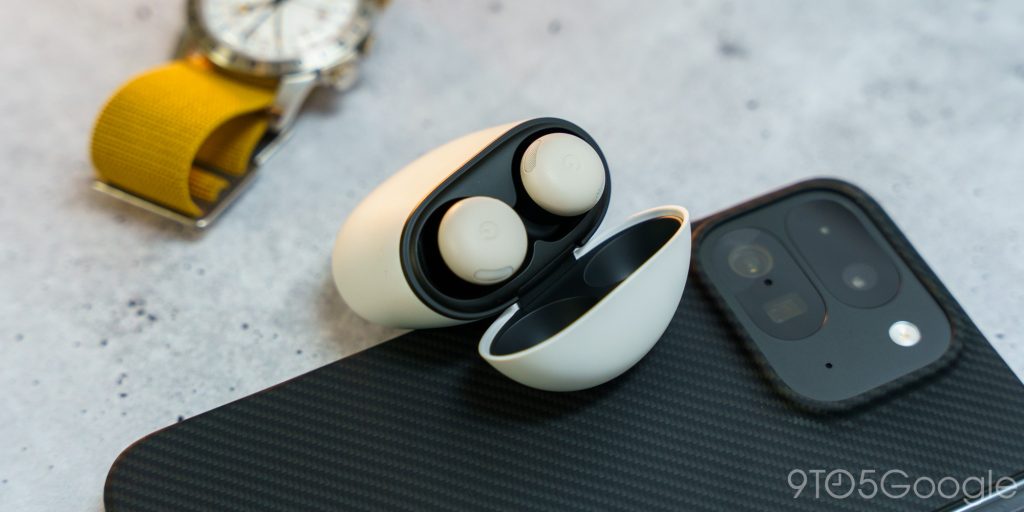
From that perspective, these are good earbuds. They get the job done and fit nicely into Google’s ecosystem, especially if you plan on using Fast Pair or Multipoint between devices. However, those looking for some great, audio-focused earbuds might want to look elsewhere.
At $229, the Pixel Buds Pro 2 are more like productive powerhouses that make things a little easier on the go or in the office, though I don’t know if Google added much in the way of quality to justify the price. You can certainly relax and jam out to music, but it won’t be the singular best option if that’s all you want. The value, rather, is in the software and in Gemini.
Abner Li and Damien Wilde contributed to this review.
FTC: We use income earning auto affiliate links. More.






Comments